HSC230 Assignment 2: Cultural Diversity Action Plan Analysis
VerifiedAdded on 2022/12/14
|10
|2208
|63
Project
AI Summary
This assignment presents a detailed cultural diversity action plan designed to enhance cultural competence in healthcare practice. The plan includes an introduction defining cultural competence and its importance, followed by clearly defined goals and objectives aimed at improving individual cultural competence. It identifies necessary resources, such as training and literature, and anticipates barriers like language differences and time constraints, proposing strategies to overcome them. The action plan outlines a structured approach to implementation, including needs assessment, awareness improvement, promotion of cultural sensitivity through community outreach, and stakeholder involvement. The rationale emphasizes the critical role of cultural competence in improving patient outcomes and satisfaction, detailing the implementation process, required resources, and methods for monitoring progress and conducting evaluations. The assignment emphasizes the importance of reflection, feedback, and continuous self-assessment to ensure the plan's effectiveness in promoting cultural safety within healthcare.
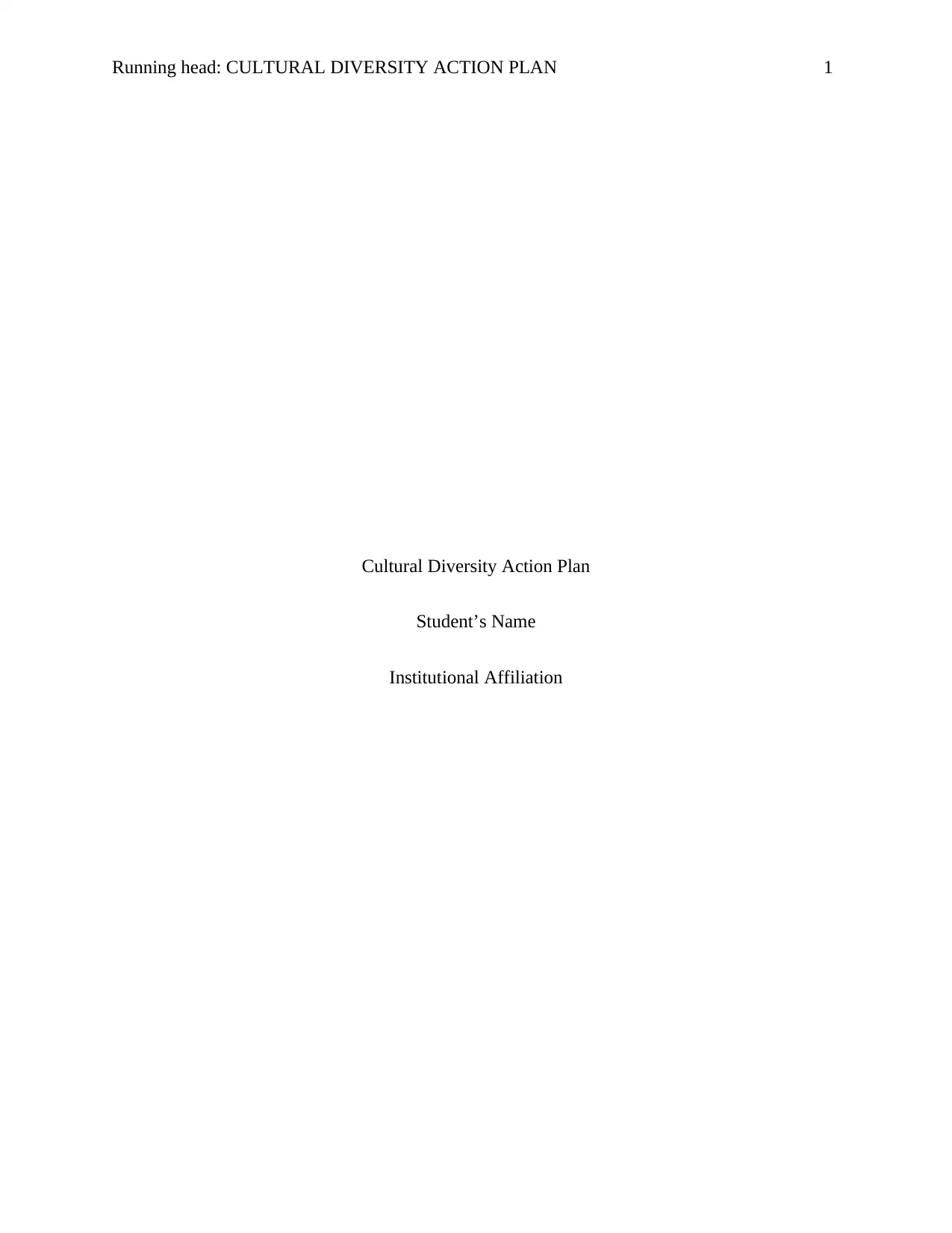
Running head: CULTURAL DIVERSITY ACTION PLAN 1
Cultural Diversity Action Plan
Student’s Name
Institutional Affiliation
Cultural Diversity Action Plan
Student’s Name
Institutional Affiliation
Paraphrase This Document
Need a fresh take? Get an instant paraphrase of this document with our AI Paraphraser
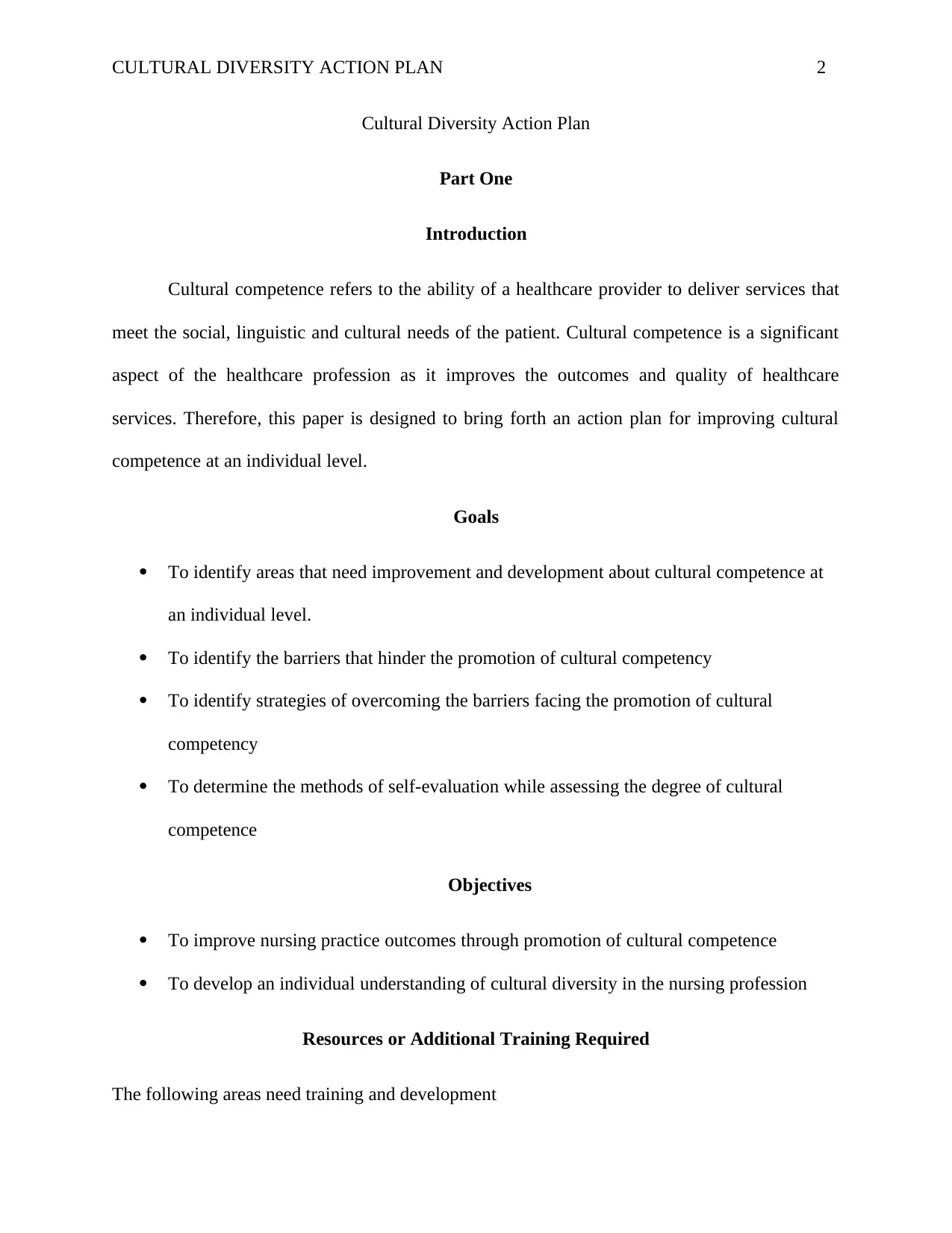
CULTURAL DIVERSITY ACTION PLAN 2
Cultural Diversity Action Plan
Part One
Introduction
Cultural competence refers to the ability of a healthcare provider to deliver services that
meet the social, linguistic and cultural needs of the patient. Cultural competence is a significant
aspect of the healthcare profession as it improves the outcomes and quality of healthcare
services. Therefore, this paper is designed to bring forth an action plan for improving cultural
competence at an individual level.
Goals
To identify areas that need improvement and development about cultural competence at
an individual level.
To identify the barriers that hinder the promotion of cultural competency
To identify strategies of overcoming the barriers facing the promotion of cultural
competency
To determine the methods of self-evaluation while assessing the degree of cultural
competence
Objectives
To improve nursing practice outcomes through promotion of cultural competence
To develop an individual understanding of cultural diversity in the nursing profession
Resources or Additional Training Required
The following areas need training and development
Cultural Diversity Action Plan
Part One
Introduction
Cultural competence refers to the ability of a healthcare provider to deliver services that
meet the social, linguistic and cultural needs of the patient. Cultural competence is a significant
aspect of the healthcare profession as it improves the outcomes and quality of healthcare
services. Therefore, this paper is designed to bring forth an action plan for improving cultural
competence at an individual level.
Goals
To identify areas that need improvement and development about cultural competence at
an individual level.
To identify the barriers that hinder the promotion of cultural competency
To identify strategies of overcoming the barriers facing the promotion of cultural
competency
To determine the methods of self-evaluation while assessing the degree of cultural
competence
Objectives
To improve nursing practice outcomes through promotion of cultural competence
To develop an individual understanding of cultural diversity in the nursing profession
Resources or Additional Training Required
The following areas need training and development
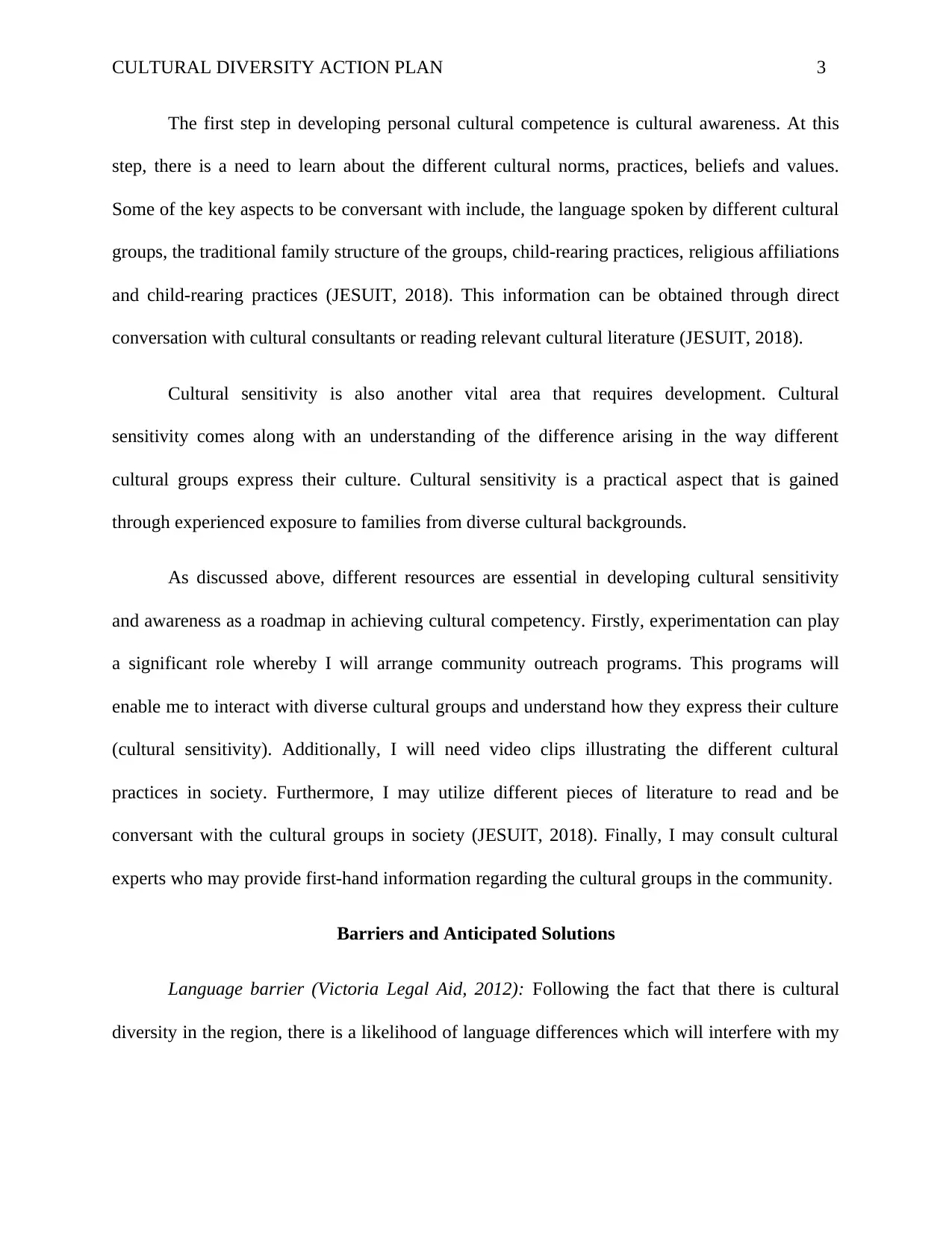
CULTURAL DIVERSITY ACTION PLAN 3
The first step in developing personal cultural competence is cultural awareness. At this
step, there is a need to learn about the different cultural norms, practices, beliefs and values.
Some of the key aspects to be conversant with include, the language spoken by different cultural
groups, the traditional family structure of the groups, child-rearing practices, religious affiliations
and child-rearing practices (JESUIT, 2018). This information can be obtained through direct
conversation with cultural consultants or reading relevant cultural literature (JESUIT, 2018).
Cultural sensitivity is also another vital area that requires development. Cultural
sensitivity comes along with an understanding of the difference arising in the way different
cultural groups express their culture. Cultural sensitivity is a practical aspect that is gained
through experienced exposure to families from diverse cultural backgrounds.
As discussed above, different resources are essential in developing cultural sensitivity
and awareness as a roadmap in achieving cultural competency. Firstly, experimentation can play
a significant role whereby I will arrange community outreach programs. This programs will
enable me to interact with diverse cultural groups and understand how they express their culture
(cultural sensitivity). Additionally, I will need video clips illustrating the different cultural
practices in society. Furthermore, I may utilize different pieces of literature to read and be
conversant with the cultural groups in society (JESUIT, 2018). Finally, I may consult cultural
experts who may provide first-hand information regarding the cultural groups in the community.
Barriers and Anticipated Solutions
Language barrier (Victoria Legal Aid, 2012): Following the fact that there is cultural
diversity in the region, there is a likelihood of language differences which will interfere with my
The first step in developing personal cultural competence is cultural awareness. At this
step, there is a need to learn about the different cultural norms, practices, beliefs and values.
Some of the key aspects to be conversant with include, the language spoken by different cultural
groups, the traditional family structure of the groups, child-rearing practices, religious affiliations
and child-rearing practices (JESUIT, 2018). This information can be obtained through direct
conversation with cultural consultants or reading relevant cultural literature (JESUIT, 2018).
Cultural sensitivity is also another vital area that requires development. Cultural
sensitivity comes along with an understanding of the difference arising in the way different
cultural groups express their culture. Cultural sensitivity is a practical aspect that is gained
through experienced exposure to families from diverse cultural backgrounds.
As discussed above, different resources are essential in developing cultural sensitivity
and awareness as a roadmap in achieving cultural competency. Firstly, experimentation can play
a significant role whereby I will arrange community outreach programs. This programs will
enable me to interact with diverse cultural groups and understand how they express their culture
(cultural sensitivity). Additionally, I will need video clips illustrating the different cultural
practices in society. Furthermore, I may utilize different pieces of literature to read and be
conversant with the cultural groups in society (JESUIT, 2018). Finally, I may consult cultural
experts who may provide first-hand information regarding the cultural groups in the community.
Barriers and Anticipated Solutions
Language barrier (Victoria Legal Aid, 2012): Following the fact that there is cultural
diversity in the region, there is a likelihood of language differences which will interfere with my
⊘ This is a preview!⊘
Do you want full access?
Subscribe today to unlock all pages.

Trusted by 1+ million students worldwide
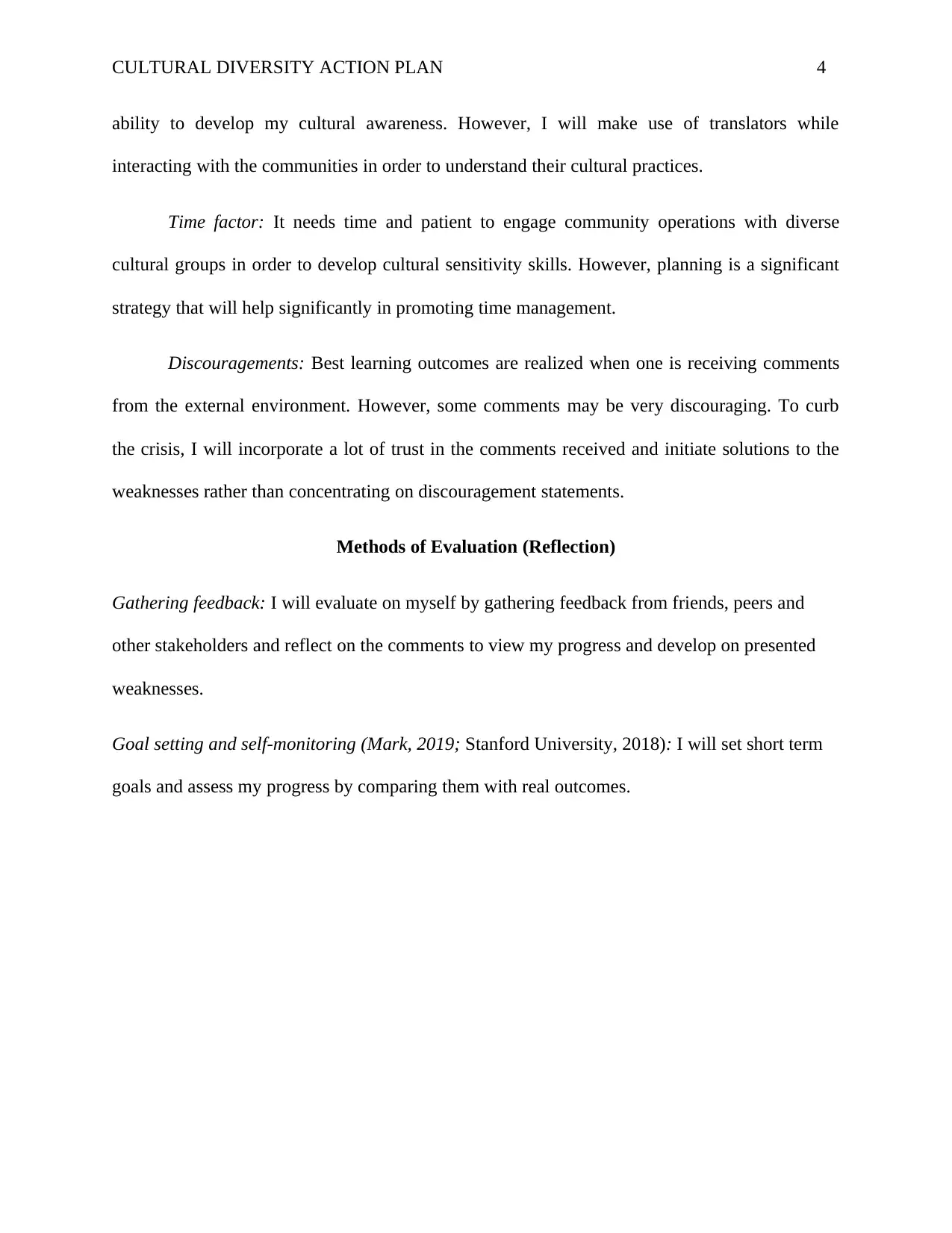
CULTURAL DIVERSITY ACTION PLAN 4
ability to develop my cultural awareness. However, I will make use of translators while
interacting with the communities in order to understand their cultural practices.
Time factor: It needs time and patient to engage community operations with diverse
cultural groups in order to develop cultural sensitivity skills. However, planning is a significant
strategy that will help significantly in promoting time management.
Discouragements: Best learning outcomes are realized when one is receiving comments
from the external environment. However, some comments may be very discouraging. To curb
the crisis, I will incorporate a lot of trust in the comments received and initiate solutions to the
weaknesses rather than concentrating on discouragement statements.
Methods of Evaluation (Reflection)
Gathering feedback: I will evaluate on myself by gathering feedback from friends, peers and
other stakeholders and reflect on the comments to view my progress and develop on presented
weaknesses.
Goal setting and self-monitoring (Mark, 2019; Stanford University, 2018): I will set short term
goals and assess my progress by comparing them with real outcomes.
ability to develop my cultural awareness. However, I will make use of translators while
interacting with the communities in order to understand their cultural practices.
Time factor: It needs time and patient to engage community operations with diverse
cultural groups in order to develop cultural sensitivity skills. However, planning is a significant
strategy that will help significantly in promoting time management.
Discouragements: Best learning outcomes are realized when one is receiving comments
from the external environment. However, some comments may be very discouraging. To curb
the crisis, I will incorporate a lot of trust in the comments received and initiate solutions to the
weaknesses rather than concentrating on discouragement statements.
Methods of Evaluation (Reflection)
Gathering feedback: I will evaluate on myself by gathering feedback from friends, peers and
other stakeholders and reflect on the comments to view my progress and develop on presented
weaknesses.
Goal setting and self-monitoring (Mark, 2019; Stanford University, 2018): I will set short term
goals and assess my progress by comparing them with real outcomes.
Paraphrase This Document
Need a fresh take? Get an instant paraphrase of this document with our AI Paraphraser
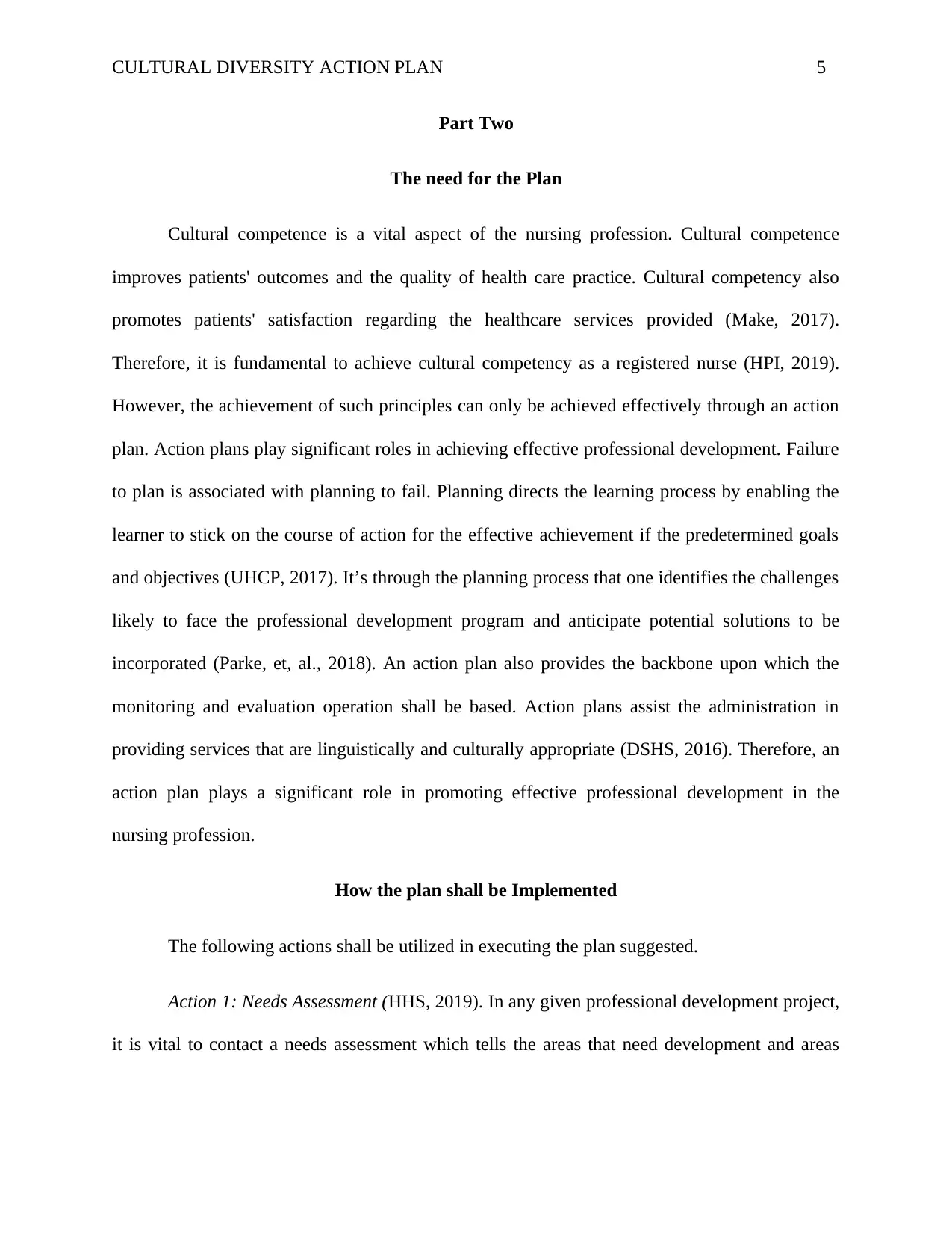
CULTURAL DIVERSITY ACTION PLAN 5
Part Two
The need for the Plan
Cultural competence is a vital aspect of the nursing profession. Cultural competence
improves patients' outcomes and the quality of health care practice. Cultural competency also
promotes patients' satisfaction regarding the healthcare services provided (Make, 2017).
Therefore, it is fundamental to achieve cultural competency as a registered nurse (HPI, 2019).
However, the achievement of such principles can only be achieved effectively through an action
plan. Action plans play significant roles in achieving effective professional development. Failure
to plan is associated with planning to fail. Planning directs the learning process by enabling the
learner to stick on the course of action for the effective achievement if the predetermined goals
and objectives (UHCP, 2017). It’s through the planning process that one identifies the challenges
likely to face the professional development program and anticipate potential solutions to be
incorporated (Parke, et, al., 2018). An action plan also provides the backbone upon which the
monitoring and evaluation operation shall be based. Action plans assist the administration in
providing services that are linguistically and culturally appropriate (DSHS, 2016). Therefore, an
action plan plays a significant role in promoting effective professional development in the
nursing profession.
How the plan shall be Implemented
The following actions shall be utilized in executing the plan suggested.
Action 1: Needs Assessment (HHS, 2019). In any given professional development project,
it is vital to contact a needs assessment which tells the areas that need development and areas
Part Two
The need for the Plan
Cultural competence is a vital aspect of the nursing profession. Cultural competence
improves patients' outcomes and the quality of health care practice. Cultural competency also
promotes patients' satisfaction regarding the healthcare services provided (Make, 2017).
Therefore, it is fundamental to achieve cultural competency as a registered nurse (HPI, 2019).
However, the achievement of such principles can only be achieved effectively through an action
plan. Action plans play significant roles in achieving effective professional development. Failure
to plan is associated with planning to fail. Planning directs the learning process by enabling the
learner to stick on the course of action for the effective achievement if the predetermined goals
and objectives (UHCP, 2017). It’s through the planning process that one identifies the challenges
likely to face the professional development program and anticipate potential solutions to be
incorporated (Parke, et, al., 2018). An action plan also provides the backbone upon which the
monitoring and evaluation operation shall be based. Action plans assist the administration in
providing services that are linguistically and culturally appropriate (DSHS, 2016). Therefore, an
action plan plays a significant role in promoting effective professional development in the
nursing profession.
How the plan shall be Implemented
The following actions shall be utilized in executing the plan suggested.
Action 1: Needs Assessment (HHS, 2019). In any given professional development project,
it is vital to contact a needs assessment which tells the areas that need development and areas
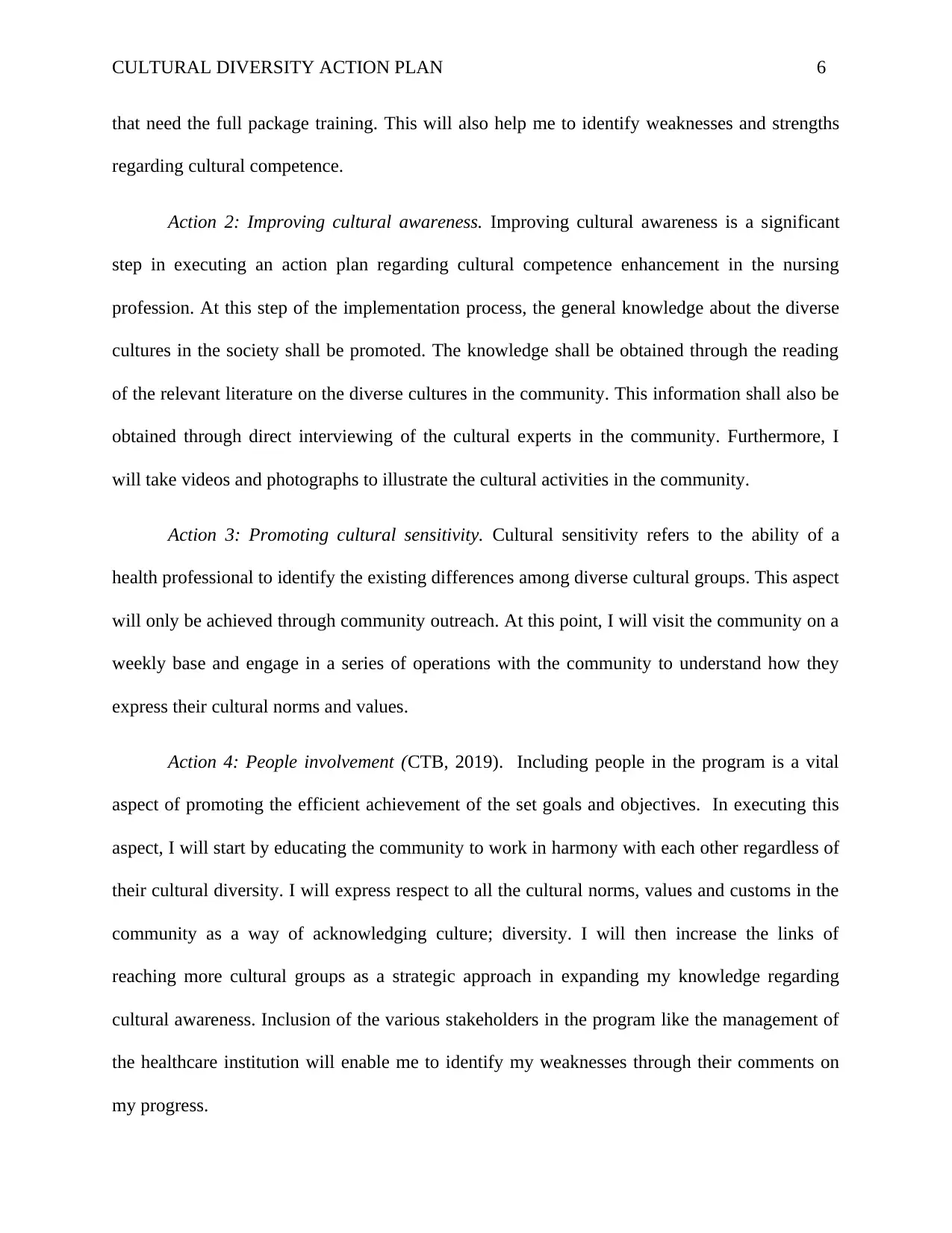
CULTURAL DIVERSITY ACTION PLAN 6
that need the full package training. This will also help me to identify weaknesses and strengths
regarding cultural competence.
Action 2: Improving cultural awareness. Improving cultural awareness is a significant
step in executing an action plan regarding cultural competence enhancement in the nursing
profession. At this step of the implementation process, the general knowledge about the diverse
cultures in the society shall be promoted. The knowledge shall be obtained through the reading
of the relevant literature on the diverse cultures in the community. This information shall also be
obtained through direct interviewing of the cultural experts in the community. Furthermore, I
will take videos and photographs to illustrate the cultural activities in the community.
Action 3: Promoting cultural sensitivity. Cultural sensitivity refers to the ability of a
health professional to identify the existing differences among diverse cultural groups. This aspect
will only be achieved through community outreach. At this point, I will visit the community on a
weekly base and engage in a series of operations with the community to understand how they
express their cultural norms and values.
Action 4: People involvement (CTB, 2019). Including people in the program is a vital
aspect of promoting the efficient achievement of the set goals and objectives. In executing this
aspect, I will start by educating the community to work in harmony with each other regardless of
their cultural diversity. I will express respect to all the cultural norms, values and customs in the
community as a way of acknowledging culture; diversity. I will then increase the links of
reaching more cultural groups as a strategic approach in expanding my knowledge regarding
cultural awareness. Inclusion of the various stakeholders in the program like the management of
the healthcare institution will enable me to identify my weaknesses through their comments on
my progress.
that need the full package training. This will also help me to identify weaknesses and strengths
regarding cultural competence.
Action 2: Improving cultural awareness. Improving cultural awareness is a significant
step in executing an action plan regarding cultural competence enhancement in the nursing
profession. At this step of the implementation process, the general knowledge about the diverse
cultures in the society shall be promoted. The knowledge shall be obtained through the reading
of the relevant literature on the diverse cultures in the community. This information shall also be
obtained through direct interviewing of the cultural experts in the community. Furthermore, I
will take videos and photographs to illustrate the cultural activities in the community.
Action 3: Promoting cultural sensitivity. Cultural sensitivity refers to the ability of a
health professional to identify the existing differences among diverse cultural groups. This aspect
will only be achieved through community outreach. At this point, I will visit the community on a
weekly base and engage in a series of operations with the community to understand how they
express their cultural norms and values.
Action 4: People involvement (CTB, 2019). Including people in the program is a vital
aspect of promoting the efficient achievement of the set goals and objectives. In executing this
aspect, I will start by educating the community to work in harmony with each other regardless of
their cultural diversity. I will express respect to all the cultural norms, values and customs in the
community as a way of acknowledging culture; diversity. I will then increase the links of
reaching more cultural groups as a strategic approach in expanding my knowledge regarding
cultural awareness. Inclusion of the various stakeholders in the program like the management of
the healthcare institution will enable me to identify my weaknesses through their comments on
my progress.
⊘ This is a preview!⊘
Do you want full access?
Subscribe today to unlock all pages.

Trusted by 1+ million students worldwide
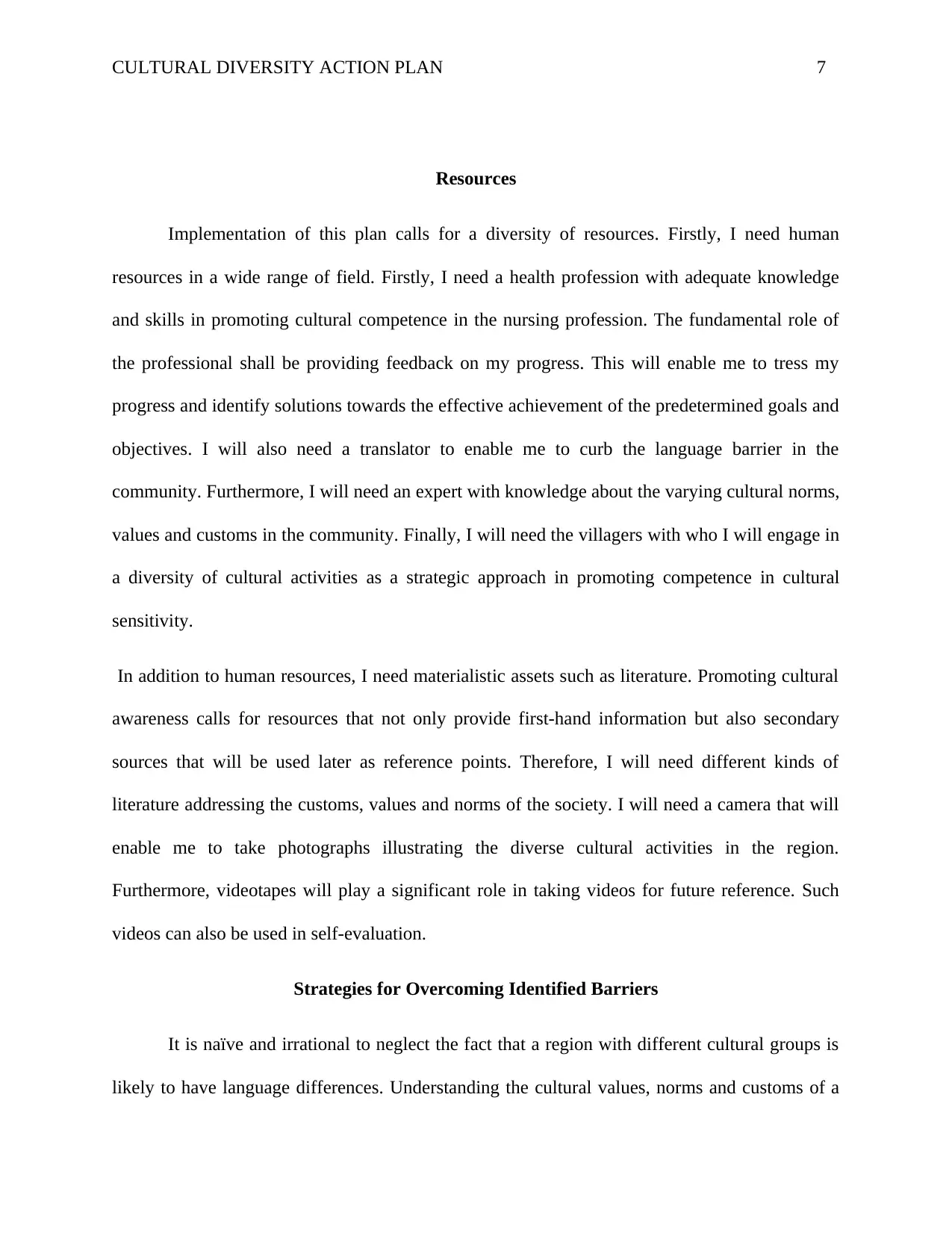
CULTURAL DIVERSITY ACTION PLAN 7
Resources
Implementation of this plan calls for a diversity of resources. Firstly, I need human
resources in a wide range of field. Firstly, I need a health profession with adequate knowledge
and skills in promoting cultural competence in the nursing profession. The fundamental role of
the professional shall be providing feedback on my progress. This will enable me to tress my
progress and identify solutions towards the effective achievement of the predetermined goals and
objectives. I will also need a translator to enable me to curb the language barrier in the
community. Furthermore, I will need an expert with knowledge about the varying cultural norms,
values and customs in the community. Finally, I will need the villagers with who I will engage in
a diversity of cultural activities as a strategic approach in promoting competence in cultural
sensitivity.
In addition to human resources, I need materialistic assets such as literature. Promoting cultural
awareness calls for resources that not only provide first-hand information but also secondary
sources that will be used later as reference points. Therefore, I will need different kinds of
literature addressing the customs, values and norms of the society. I will need a camera that will
enable me to take photographs illustrating the diverse cultural activities in the region.
Furthermore, videotapes will play a significant role in taking videos for future reference. Such
videos can also be used in self-evaluation.
Strategies for Overcoming Identified Barriers
It is naïve and irrational to neglect the fact that a region with different cultural groups is
likely to have language differences. Understanding the cultural values, norms and customs of a
Resources
Implementation of this plan calls for a diversity of resources. Firstly, I need human
resources in a wide range of field. Firstly, I need a health profession with adequate knowledge
and skills in promoting cultural competence in the nursing profession. The fundamental role of
the professional shall be providing feedback on my progress. This will enable me to tress my
progress and identify solutions towards the effective achievement of the predetermined goals and
objectives. I will also need a translator to enable me to curb the language barrier in the
community. Furthermore, I will need an expert with knowledge about the varying cultural norms,
values and customs in the community. Finally, I will need the villagers with who I will engage in
a diversity of cultural activities as a strategic approach in promoting competence in cultural
sensitivity.
In addition to human resources, I need materialistic assets such as literature. Promoting cultural
awareness calls for resources that not only provide first-hand information but also secondary
sources that will be used later as reference points. Therefore, I will need different kinds of
literature addressing the customs, values and norms of the society. I will need a camera that will
enable me to take photographs illustrating the diverse cultural activities in the region.
Furthermore, videotapes will play a significant role in taking videos for future reference. Such
videos can also be used in self-evaluation.
Strategies for Overcoming Identified Barriers
It is naïve and irrational to neglect the fact that a region with different cultural groups is
likely to have language differences. Understanding the cultural values, norms and customs of a
Paraphrase This Document
Need a fresh take? Get an instant paraphrase of this document with our AI Paraphraser
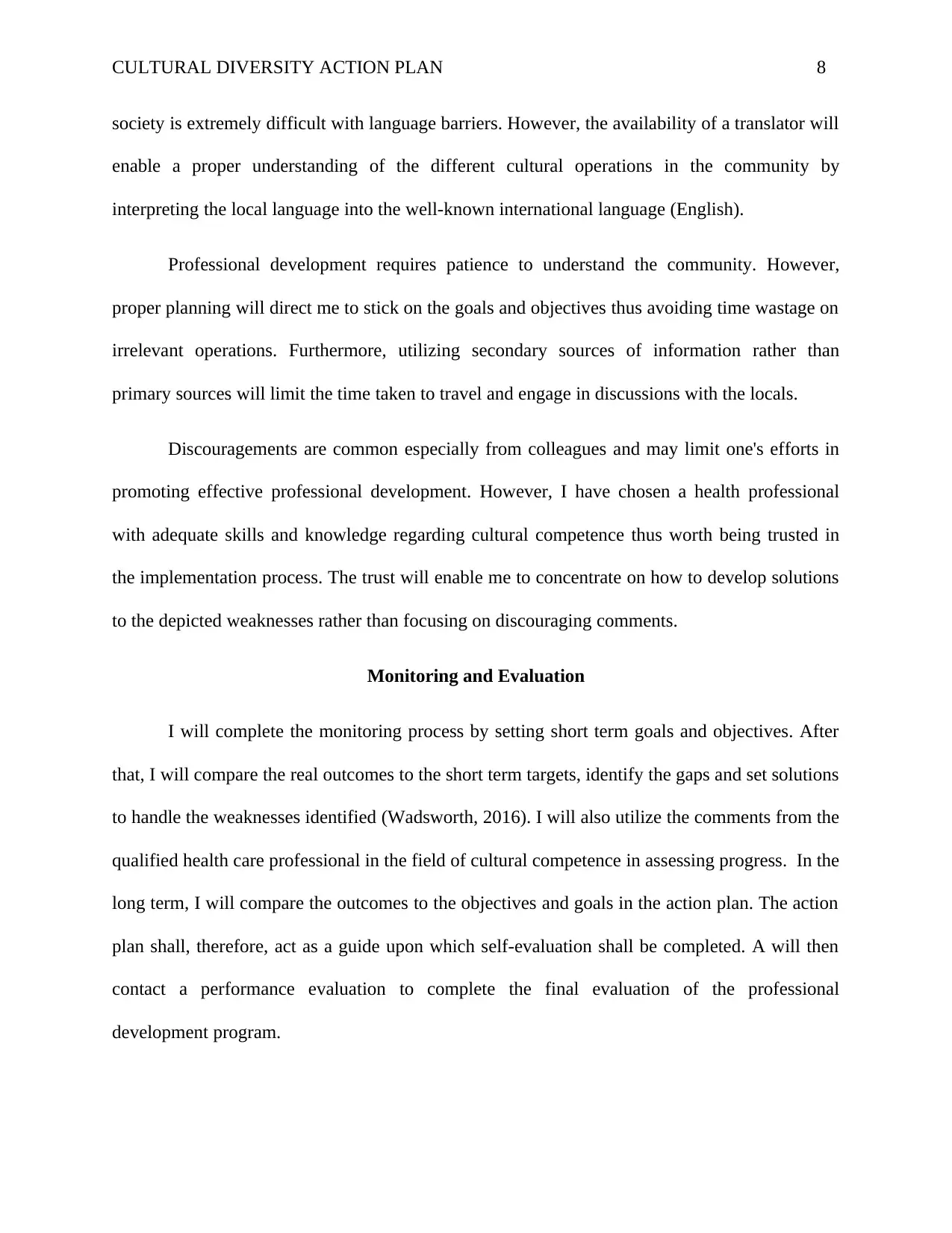
CULTURAL DIVERSITY ACTION PLAN 8
society is extremely difficult with language barriers. However, the availability of a translator will
enable a proper understanding of the different cultural operations in the community by
interpreting the local language into the well-known international language (English).
Professional development requires patience to understand the community. However,
proper planning will direct me to stick on the goals and objectives thus avoiding time wastage on
irrelevant operations. Furthermore, utilizing secondary sources of information rather than
primary sources will limit the time taken to travel and engage in discussions with the locals.
Discouragements are common especially from colleagues and may limit one's efforts in
promoting effective professional development. However, I have chosen a health professional
with adequate skills and knowledge regarding cultural competence thus worth being trusted in
the implementation process. The trust will enable me to concentrate on how to develop solutions
to the depicted weaknesses rather than focusing on discouraging comments.
Monitoring and Evaluation
I will complete the monitoring process by setting short term goals and objectives. After
that, I will compare the real outcomes to the short term targets, identify the gaps and set solutions
to handle the weaknesses identified (Wadsworth, 2016). I will also utilize the comments from the
qualified health care professional in the field of cultural competence in assessing progress. In the
long term, I will compare the outcomes to the objectives and goals in the action plan. The action
plan shall, therefore, act as a guide upon which self-evaluation shall be completed. A will then
contact a performance evaluation to complete the final evaluation of the professional
development program.
society is extremely difficult with language barriers. However, the availability of a translator will
enable a proper understanding of the different cultural operations in the community by
interpreting the local language into the well-known international language (English).
Professional development requires patience to understand the community. However,
proper planning will direct me to stick on the goals and objectives thus avoiding time wastage on
irrelevant operations. Furthermore, utilizing secondary sources of information rather than
primary sources will limit the time taken to travel and engage in discussions with the locals.
Discouragements are common especially from colleagues and may limit one's efforts in
promoting effective professional development. However, I have chosen a health professional
with adequate skills and knowledge regarding cultural competence thus worth being trusted in
the implementation process. The trust will enable me to concentrate on how to develop solutions
to the depicted weaknesses rather than focusing on discouraging comments.
Monitoring and Evaluation
I will complete the monitoring process by setting short term goals and objectives. After
that, I will compare the real outcomes to the short term targets, identify the gaps and set solutions
to handle the weaknesses identified (Wadsworth, 2016). I will also utilize the comments from the
qualified health care professional in the field of cultural competence in assessing progress. In the
long term, I will compare the outcomes to the objectives and goals in the action plan. The action
plan shall, therefore, act as a guide upon which self-evaluation shall be completed. A will then
contact a performance evaluation to complete the final evaluation of the professional
development program.
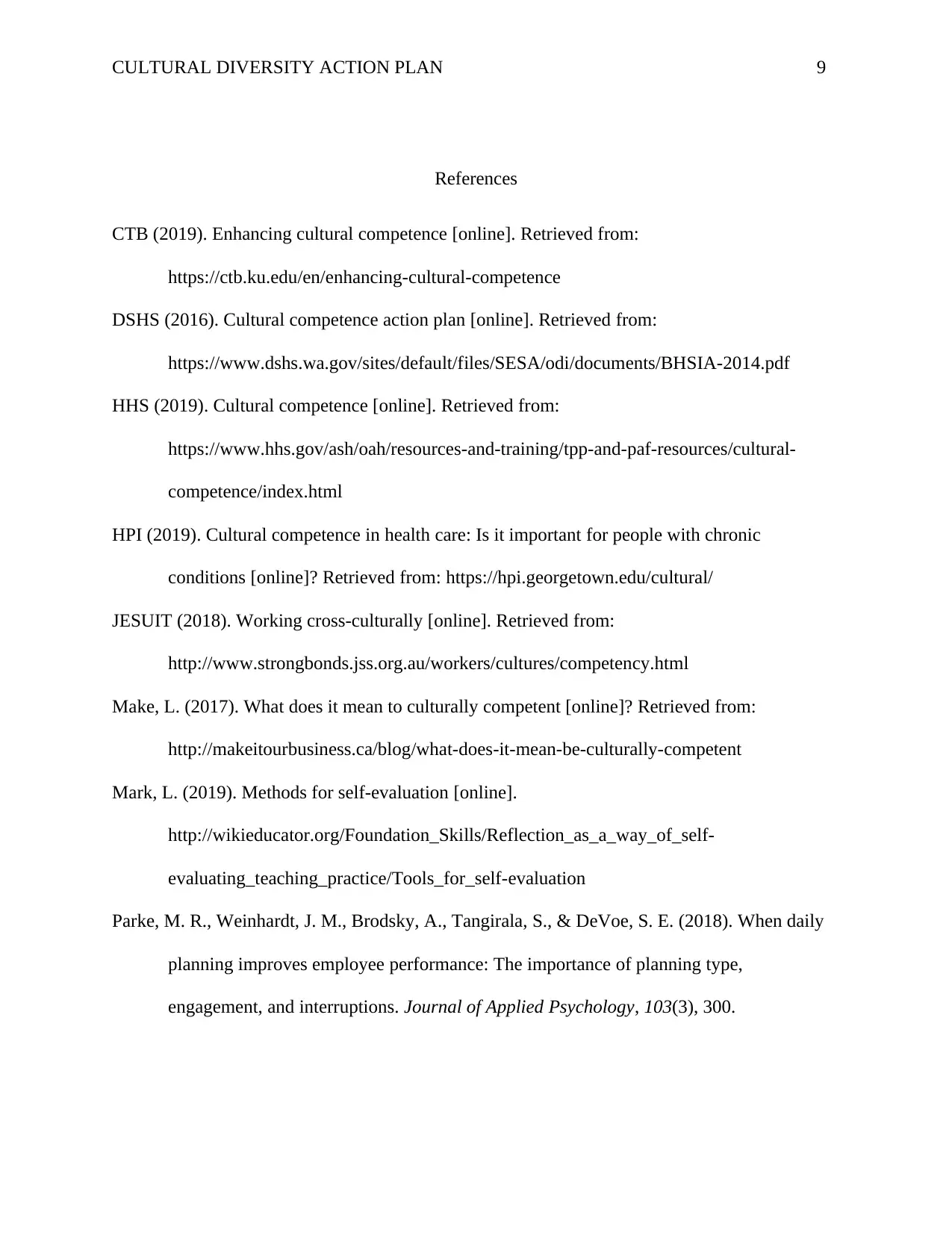
CULTURAL DIVERSITY ACTION PLAN 9
References
CTB (2019). Enhancing cultural competence [online]. Retrieved from:
https://ctb.ku.edu/en/enhancing-cultural-competence
DSHS (2016). Cultural competence action plan [online]. Retrieved from:
https://www.dshs.wa.gov/sites/default/files/SESA/odi/documents/BHSIA-2014.pdf
HHS (2019). Cultural competence [online]. Retrieved from:
https://www.hhs.gov/ash/oah/resources-and-training/tpp-and-paf-resources/cultural-
competence/index.html
HPI (2019). Cultural competence in health care: Is it important for people with chronic
conditions [online]? Retrieved from: https://hpi.georgetown.edu/cultural/
JESUIT (2018). Working cross-culturally [online]. Retrieved from:
http://www.strongbonds.jss.org.au/workers/cultures/competency.html
Make, L. (2017). What does it mean to culturally competent [online]? Retrieved from:
http://makeitourbusiness.ca/blog/what-does-it-mean-be-culturally-competent
Mark, L. (2019). Methods for self-evaluation [online].
http://wikieducator.org/Foundation_Skills/Reflection_as_a_way_of_self-
evaluating_teaching_practice/Tools_for_self-evaluation
Parke, M. R., Weinhardt, J. M., Brodsky, A., Tangirala, S., & DeVoe, S. E. (2018). When daily
planning improves employee performance: The importance of planning type,
engagement, and interruptions. Journal of Applied Psychology, 103(3), 300.
References
CTB (2019). Enhancing cultural competence [online]. Retrieved from:
https://ctb.ku.edu/en/enhancing-cultural-competence
DSHS (2016). Cultural competence action plan [online]. Retrieved from:
https://www.dshs.wa.gov/sites/default/files/SESA/odi/documents/BHSIA-2014.pdf
HHS (2019). Cultural competence [online]. Retrieved from:
https://www.hhs.gov/ash/oah/resources-and-training/tpp-and-paf-resources/cultural-
competence/index.html
HPI (2019). Cultural competence in health care: Is it important for people with chronic
conditions [online]? Retrieved from: https://hpi.georgetown.edu/cultural/
JESUIT (2018). Working cross-culturally [online]. Retrieved from:
http://www.strongbonds.jss.org.au/workers/cultures/competency.html
Make, L. (2017). What does it mean to culturally competent [online]? Retrieved from:
http://makeitourbusiness.ca/blog/what-does-it-mean-be-culturally-competent
Mark, L. (2019). Methods for self-evaluation [online].
http://wikieducator.org/Foundation_Skills/Reflection_as_a_way_of_self-
evaluating_teaching_practice/Tools_for_self-evaluation
Parke, M. R., Weinhardt, J. M., Brodsky, A., Tangirala, S., & DeVoe, S. E. (2018). When daily
planning improves employee performance: The importance of planning type,
engagement, and interruptions. Journal of Applied Psychology, 103(3), 300.
⊘ This is a preview!⊘
Do you want full access?
Subscribe today to unlock all pages.

Trusted by 1+ million students worldwide
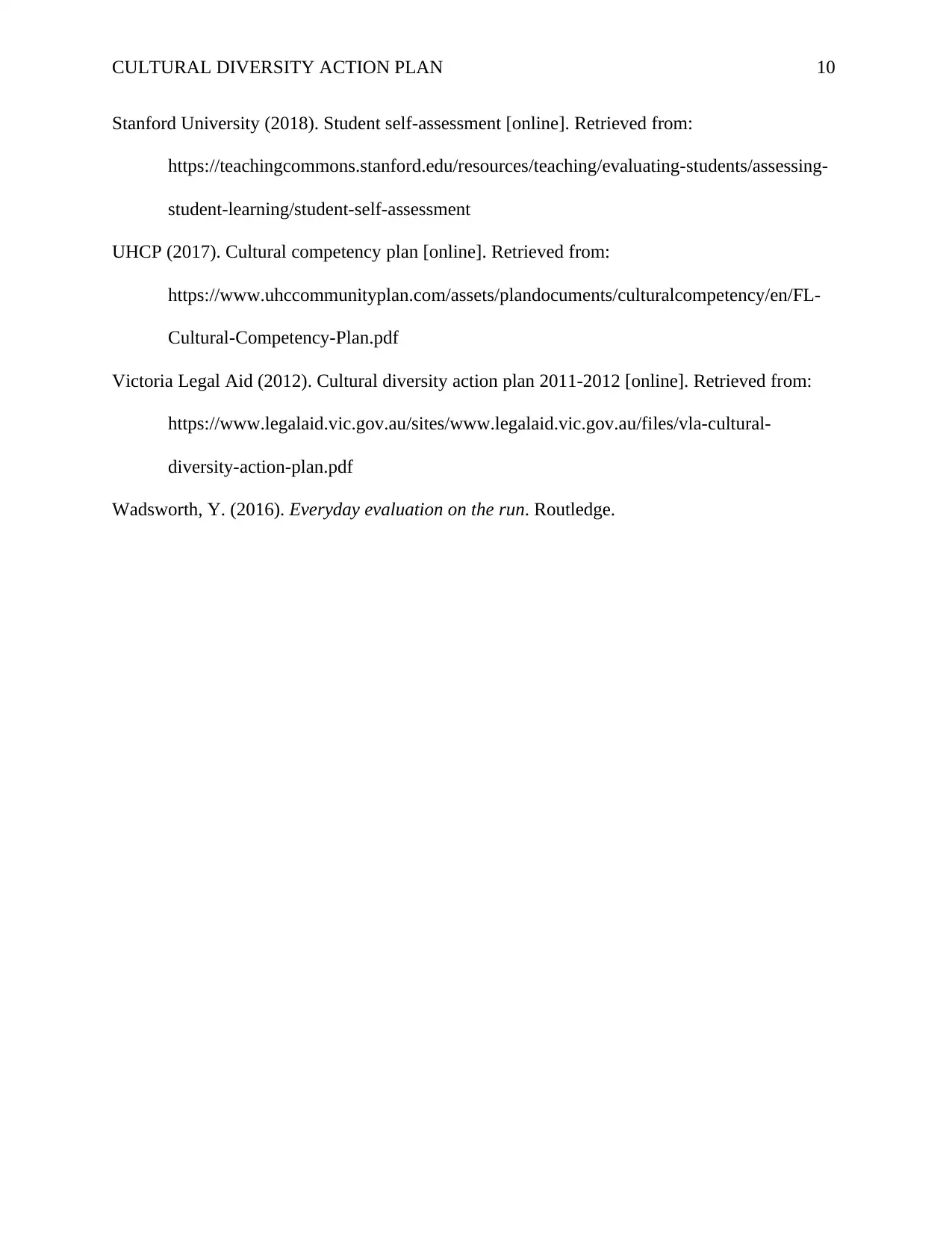
CULTURAL DIVERSITY ACTION PLAN 10
Stanford University (2018). Student self-assessment [online]. Retrieved from:
https://teachingcommons.stanford.edu/resources/teaching/evaluating-students/assessing-
student-learning/student-self-assessment
UHCP (2017). Cultural competency plan [online]. Retrieved from:
https://www.uhccommunityplan.com/assets/plandocuments/culturalcompetency/en/FL-
Cultural-Competency-Plan.pdf
Victoria Legal Aid (2012). Cultural diversity action plan 2011-2012 [online]. Retrieved from:
https://www.legalaid.vic.gov.au/sites/www.legalaid.vic.gov.au/files/vla-cultural-
diversity-action-plan.pdf
Wadsworth, Y. (2016). Everyday evaluation on the run. Routledge.
Stanford University (2018). Student self-assessment [online]. Retrieved from:
https://teachingcommons.stanford.edu/resources/teaching/evaluating-students/assessing-
student-learning/student-self-assessment
UHCP (2017). Cultural competency plan [online]. Retrieved from:
https://www.uhccommunityplan.com/assets/plandocuments/culturalcompetency/en/FL-
Cultural-Competency-Plan.pdf
Victoria Legal Aid (2012). Cultural diversity action plan 2011-2012 [online]. Retrieved from:
https://www.legalaid.vic.gov.au/sites/www.legalaid.vic.gov.au/files/vla-cultural-
diversity-action-plan.pdf
Wadsworth, Y. (2016). Everyday evaluation on the run. Routledge.
1 out of 10
Related Documents
Your All-in-One AI-Powered Toolkit for Academic Success.
+13062052269
info@desklib.com
Available 24*7 on WhatsApp / Email
![[object Object]](/_next/static/media/star-bottom.7253800d.svg)
Unlock your academic potential
Copyright © 2020–2025 A2Z Services. All Rights Reserved. Developed and managed by ZUCOL.





